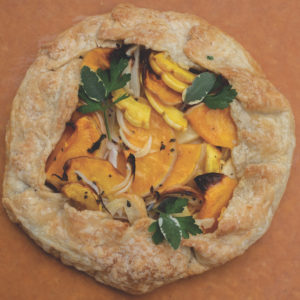
Winter squash was legend in my house growing up. One Halloween, my mother wouldn’t let my sisters trick-or-treat until they ate their acorn squash. No squash, no candy. Ultimately, she recanted, but it haunted us every time the dark gourd was served. The truth is many old-school squashes are bland (sorry, acorn) — that’s why they get amped up with lots of butter, brown or maple sugar, and sweet spices. Newer winter squash varieties bring more to the table. I actually am happy when I see those in the market.
The workhouse butternut shares space with striped delicata, sweet dumplings, kabocha, and red kuri. The latest darling is the honeynut, a diminutive butternut, with a fuller and sweeter flavor than the usual ones. The honeynut is just big enough for a single serving, but stands on its own without added sugars. I was thrilled when I found some at the Orleans Farmers Market.
This squash was developed by the seed scientist Michael Mazourek of Cornell University after chef Dan Barber asked an audacious question: “Can you grow a squash that tastes like something?” Their project is one of several collaborations between seed scientists, growers, and chefs, who are working on putting flavor back in our food. The Culinary Breeding Network at Oregon State University and Seed to Kitchen at the University of Wisconsin, Madison are two worth following.
Apple and winter squash — even if it’s plain old butternut — are natural together in soups, roasted, or in a winter salad. I like to sauté cubes of each in olive oil until crisp-tender and toss them with hearty greens, as if they were croutons. One of my favorite ways to combine them is in a savory galette — a.k.a. a rustic free-form pie.
Cold weather is pie weather. No more struggling in a hot kitchen with slack butter. The key to a flaky crust is using cold butter, not overworking it, and adding just enough liquid to bring it together. I make crust by hand, but a food processor is great (I just hate the cleanup). I rub the butter into the flour until the flour gets just tinted yellow, stopping when I’m still seeing nuggets of butter. An old-fashioned pastry cutter, with its curved sharp metal bands, helps to cut in the butter quickly as well. Adding a bit of vodka with the water moistens the dough without activating the gluten, keeping the dough tender. I use a pie shield around the galette, or make a folded band with foil, to help hold its pretty shape. If you suffer from fear of pie-making, store bought crust is fine, too.
If you find it, use honeynut, otherwise delicata, or half a small butternut will work fine. There are lots of ways to go with this recipe. Add lightly cooked bacon, skip the cheese, or add crumbled blue at the end. Don’t have sage? Try rosemary, thyme, or parsley.
Squash and Apple Galette
one galette, enough for 6
For the crust:
1½ cups all-purpose flour, plus more for rolling
2 Tbsp. sugar
Pinch fine salt
4 oz. unsalted butter, well chilled, and cut into small cubes
1 Tbsp. vodka
4 Tbsp. ice-cold water
For the filling:
1 baking apple, such as a honeycrisp
1 small squash (10 oz.), seeded
1 onion, halved and thinly sliced
3 fresh sage leaves, minced
3 Tbsp. unsalted butter, melted
1 Tbsp. whole grain or Dijon mustard
¼ cup diced cheddar cheese
Fresh ground black pepper
In a food processor, pulse the flour, sugar, and salt. Add the butter and pulse until the mixture resembles coarse cornmeal, about 15 times. Add the vodka and 3 tablespoons water, pulsing just until the dough begins to pull away from the sides of the bowl. If still powdery, add the last tablespoon of water. Turn dough out onto a sheet of parchment paper or plastic wrap, press dough together into a round disc, and refrigerate at least half hour.
Roll the dough on a lightly floured surface into a 14-inch disc. Transfer to a baking sheet lined with parchment paper or a silicone mat. Refrigerate while you prepare the filling.
Peel and core the apple. Slice the apple, squash (with skin), and onion in very thin slices. Transfer to a bowl and toss with the melted butter, sage, and cheddar; season with salt and pepper.
Brush the dough with the mustard. Pile the squash mixture on top, leaving the outer two inches free (it may feel like a lot, but it shrinks while baking). Fold the dough edges over the filling, pleating as you go, leaving the center of the filling exposed. Press into a compact circle. Refrigerate for 15 minutes.
Arrange a rack in the middle of the oven, preheat to 400°F. Bake the galette on the middle rack for 15 minutes. Reduce temperature to 375°F and bake until the pastry is golden brown and the filling is bubbling, about 45 minutes more. Serve warm or at room temperature.
